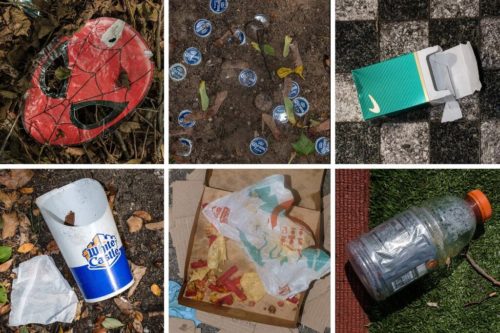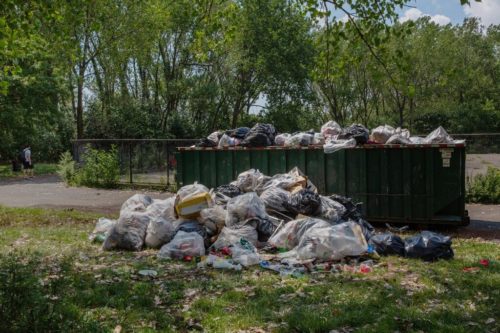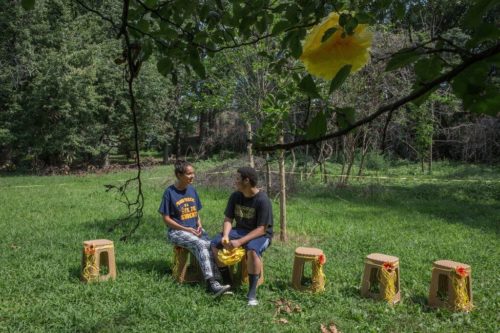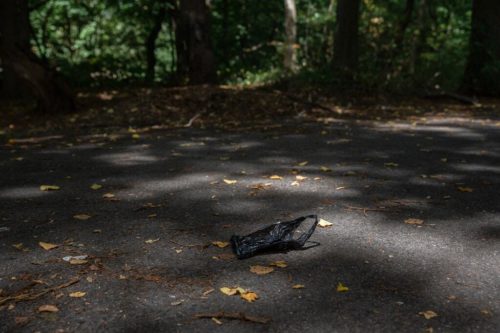
Thursday, August 27, 2020
By Sarah Maslin Nir
In a playground in the Morrisania section of the Bronx on a recent afternoon, two parents kept their toddler strapped in her stroller, afraid she might pick up the hamburger wrappers, cigarettes or hypodermic needle lying on the pavement.
In a park in Crown Heights, Brooklyn, a woman said she was afraid to walk her pit bull, who had previously sliced his paw on shattered glass in a flower bed.
And on the waterfront in Long Island City, Queens, piles of garbage towering beside overstuffed trash cans each weekend forced an emergency call for help from the group that runs the riverside parks.
A recent $84 million budget cut to New York City’s sprawling parks system, forced by the dire economic challenges the city faces because of the coronavirus pandemic, comes as the city’s green spaces are hosting gatherings that once took place in bars, reception halls and living rooms, and serving as respite for those working from home or unemployed.

In normal times, such extraordinarily heavy use would be a challenge for the parks system. But in a summer when maintenance crews are shrinking, skipped lawn trims and infrequent trash pickup have left some parkland unsightly and dirty at a time when New Yorkers say they need the city’s 1,700 green oases more than ever.
The cigarette butts, charcoal heaps and candy wrappers have a snowballing effect on quality of life, contributing to a sense of a city fraying amid the pandemic. Some New Yorkers fear that the disheveled parks are a portent of something far worse than litter: a city spiraling toward decline.
“Parks occupy 14 percent of the entire land of the City of New York, so if they are looking rough, the city looks rough and runs the risk — the fear — of going back to the way it was in the ’70s and ’80s,” said Adam Ganser, the executive director of New Yorkers for Parks, a nonprofit advocacy organization. In that era, a period of economic and social turmoil, the city’s parks fell into disrepair and became hot spots for crime.
He added: “All New Yorkers spend their time in them right now; if they are not well taken care of, then it feels like the city is not taking care of its citizens.”
In a familiar pattern of economic inequity, many residents of underserved communities feel that their parks are the most tarnished.
In Bronx Park, which contains the Bronx Zoo, Elizabeth Soto, 19, arrived at dawn on a recent Saturday to set up an outdoor baby shower for her aunt. But she had to head back home to get a rake and trash bags to pick up all the garbage: Butterfinger wrappers, charcoal briquettes and aluminum foil.

“It’s kind of depressing,” said Ms. Soto as a squirrel licked a fruit snack wrapper nearby. “We’re stuck in the house, and then we come out of the house and we have to do extra cleaning.”
That extra cleaning in past years might have been done by some 1,700 seasonal workers, who would cut grass, paint over graffiti and weed at all city parks. Because of the $84 million in cuts — about 14 percent of the New York City Department of Parks and Recreation’s total yearly budget of $587 million — those seasonal jobs went unfilled this year. The department has 45 percent less staff to handle more work, a spokeswoman said.
In recent weeks, Mayor Bill de Blasio has said that 22,000 city jobs could be cut in October, including from the parks department.
In the meantime, maintenance hours have been reduced by 25,000 hours a week, according to the department, which uses an app to track chores. Maintenance crews are able to get to about 400 fewer sites per week, the department said. In McCarren Park, in Williamsburg, Brooklyn, for example, sunbathers lounged in knee-high grass last weekend, the result of a systemwide reduced mowing schedule.
Even wealthier parks have not been fully spared: According to a spokeswoman for the Central Park Conservancy, the nonprofit organization that raises private money for that park, a drop in donations and in revenue from closed parks concessions made it necessary to reduce landscaping projects and divert resources to trash management.
Mark Focht, the parks department’s deputy commissioner and chief operating officer, said that the combination of budget cuts and increased use has left the agency struggling to keep up with the trash. The department is launching an awareness campaign urging people to take their refuse with them and will have employees hand out garbage bags at sites throughout the city.
“I am incredibly proud of our staff. They came to work straight thorough the pandemic, they were out here working every day to try and keep the places clean and presentable,” Mr. Focht said. “It is not always the condition in all places that we would like it to be, but the extent of what we can provide to the public is still critical to the health of the city.”
Fears of a crime wave have not materialized; between April and June, the last quarter for which data was available, major crimes within parks were down by about 50 percent, according to New York City Police Department data.
Yet for some, the grimy parks still seem the last straw in a teetering city.
At Hector Aponte Track and Field, in Soundview Park in the Bronx, two cousins, Terrell Alexander and William Schuyler, ran football drills on a recent weekend, stepping around Ziploc bags of mangoes with chili flakes, a Pringles tube, scattered cheese curls and sharp Heineken caps.

Mr. Alexander, 30, a facilities assistant at an environmental law firm, said there was an emotional toll in seeing such a scene in a city that has been devastated by the virus and is struggling toward a comeback. “It’s hard to come here to see that,” he said.
In Prospect Park in Brooklyn, two couples recently sat in folding chairs, surrounded by paper plates and fish bones strewn on the ground, looking at real estate listings for houses in Kingston, N.Y. They sat in a triangle of trash created by three vertiginous piles of rubbish made up of 38 full black plastic garbage bags.
One couple said they were considering moving now that theaters and other cultural attractions were shut, and the city’s vibrancy had dimmed.
“If all the things that we are here for — including a beautiful park — if that’s just another thing that’s going down the tube,” Rosie Cohe, 37, began saying, before her friend, Florencia Jocou, 39, finished the sentence: “It’s another reason to leave.”
Some have taken matters into their own hands. Ruben Diaz, Jr. the Bronx borough president, was so disgusted with the litter in Soundview Park — across the street from his home — that he started bagging it himself on Monday mornings. That has morphed into “Meaningful Mondays,” a volunteer call-to-action that has drawn up to 40 residents at a time to work alongside him for the past several weeks.

About a dozen other Bronx officials have launched similar programs, Mr. Diaz said. The Hunters Point Parks Conservancy, which oversees the waterfront parks of Long Island City, has also launched volunteer cleanup days. In Prospect Park, neighborhood groups also do cleanups. “The city is broke, the state says that they’re broke, so this is the time where we all need to put our boots on the ground,” Mr. Diaz said.